NCERT Exemplar Solutions: Food - Where does it come from | Science Class 6 PDF Download
| Table of contents |

|
| Multiple Choice Questions |

|
| Very Short Answer Questions |

|
| Short Answer Questions |

|
| Long Answer Questions |

|
Multiple Choice Questions
Q1: Given below are names of some animals.
(i) Goat
(ii) Human beings
(iii) Cockroach
(iv) Eagle
which of the above animals form a pair of omnivores?
(a) (i) and (ii)
(b) (ii) and (iii)
(c) (iii) and (iv)
(d) (ii) and (iv)
 View Answer
View AnswerAns: (b)
Humans and cockroaches eat both animals and plants so, they are omnivores. Goats eat only plants and plant products so they are herbivores. Eagles eat flesh of other animals so, they are carnivores.
Q2: Honeybee makes honey from
(a) pollen
(b) petals
(c) nectar
(d) bud.
 View Answer
View AnswerAns: (c)
Honeybees collect nectar from flowers and take it to their beehive. Honeybees convert it into honey and store it as food. Hence we get honey from beehives.
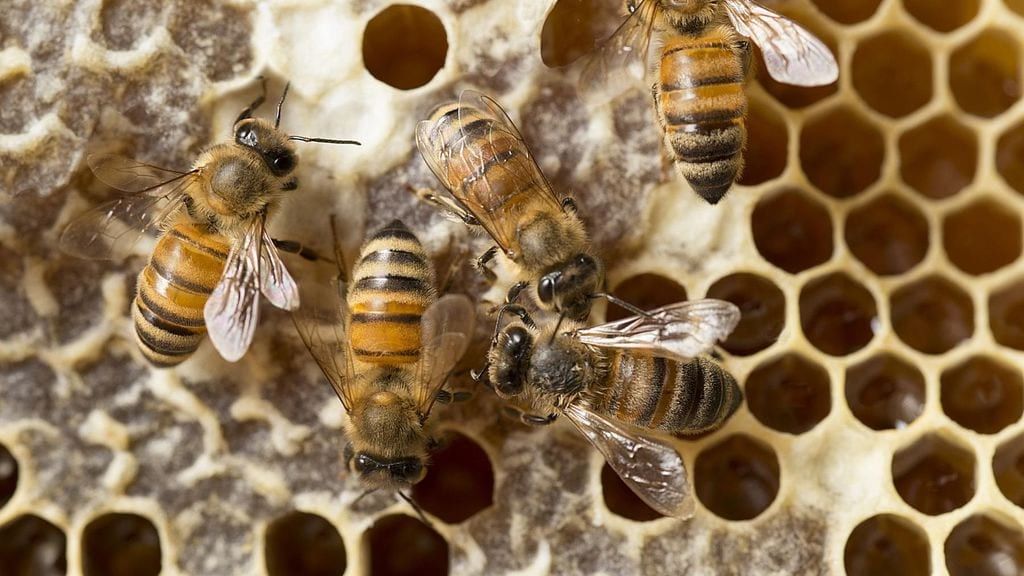 Honeybees turning nectar into honey
Honeybees turning nectar into honey
Q3: Below are the names of some animals.
(i) Cow
(ii) Sheep
(iii) Horse
(iv) Ox
Which of the above are sources of milk for human beings?
(a) (i) and (iii)
(b) (i) and (ii)
(c) (ii) and (iii)
(d) (iii) and (iv)
 View Answer
View AnswerAns: (b)
Cow and sheep are dairy animals i.e., they are kept for obtaining milk. They are also called milch animals.
Ox and horse are draught animals i.e., they are used for transportation and in agriculture.
Q4: Given below is a list of edible plants.
(i) Banana
(ii) Pumpkin
(iii) Lady’s finger
(iv) Brinjal
Which pair of plants have two or more edible parts?
(a) (i) and (ii)
(b) (ii) and (iii)
(c) (iii) and (iv)
(d) (i) and (iv)
 View Answer
View AnswerAns: (a)
In banana: stem, fruit and flower are edible and in pumpkin: flower and fruit are edible. In the lady’s finger and brinjal: only the fruit is edible.
Q5: The part of a banana plant not used as food is
(a) flower
(b) fruit
(c) stem
(d) root.
 View Answer
View AnswerAns: (d)
In banana: stem, fruit and flower are edible which are very useful.
Q6: Read each set of terms and identify the odd set.
(a) Cow, milk, butter
(b) Hen, meat, egg
(c) Goat, milk, meat
(d) Plant, vegetable, buttermilk
 View Answer
View AnswerAns: (d)
Vegetables are part of the plants whereas buttermilk is an animal product.
Very Short Answer Questions
Q7: Read the clues and fill up the blanks given below each of them.
(a) Honeybees suck from flower.
N_ _T_R
(b) Animals which eat other animals.
_A _N_V_R_S
(c) Animals which eat only plants and plant products.
HE_B_ _ _ _ E_
(d) Animals which eat both plants and animals.
_MN I_O_ _ _
 View Answer
View Answer(a) NECTAR
(b) CARNIVORES
(c) HERBIVORES
(d) OMNIVORES
Q8: Why do boiled seeds fail to sprout?
 View Answer
View AnswerBoiled seeds fail to sprout because boiling kills the seed.
Q9: Where do bees store honey?
 View Answer
View AnswerBees store honey in their beehives.
Q10: Name two ingredients in our food that are not obtained from plants or animals. Mention one source for each ingredient.
 View Answer
View AnswerTwo ingredients in our food that are not obtained from plants or animals are salt and water.
The main source of salt is obtained from seawater and from the rock.
Water is obtained from the river, well, tube well, rain etc.
Q11: Given below are jumbled words which are names of parts of a plant. Rearrange them to get the correct words.
(a) LILCHI
(b) ITRUF
(c) SEANBOYA
(d) GURSA
(e) ROUNDGUNT
 View Answer
View AnswerThe rearranged words are:
(a) CHILLI
(b) FRUIT
(c) SOYABEAN
(d) SUGAR
(e) GROUNDNUT
Short Answer Questions
Q12: Identify the animals in the grid given below as Fig. 1.1 and categorize them into herbivore, carnivore and omnivore.
 View Answer
View Answer Herbivore – Cow, Goat, Hen
Herbivore – Cow, Goat, Hen
Carnivore – Wolf, Lion, Frog
Omnivore – Cat, Rat, Crow, Human, Ant, Owl
Q13: Why should we avoid wastage of food?
 View Answer
View AnswerWe should avoid wastage of food because:
(i) Sufficient food is not available to everyone.
(ii) Food is very costly and poor people cannot afford to buy even the minimum required amount of food.
Q14: Why do organisms need food? Write two reasons.
 View Answer
View AnswerOrganisms need food because
(i) Without energy, we cannot do any activity hence food gives energy to do the work.
(ii) Food helps in building the body parts stronger.
(iii) Food contains minerals, which helps in protecting the body against diseases.
Q15: Label and colour the different parts of the plant given below in Fig. 1.2.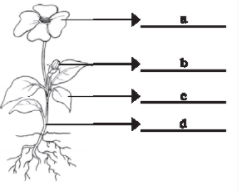
 View Answer
View Answer
(a) Flower
(b) Floral bud
(c) Leaf
(d) Stem
Long Answer Questions
Q16: Read the names of animals written in the inner ring of Fig. 1.3. Within the second ring write the types of food they eat and the category to which they belong (based on the eating habit) in the outermost ring. One example has been worked out for you. Use red, green and blue colours for writing.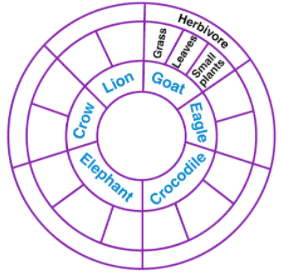
 View Answer
View Answer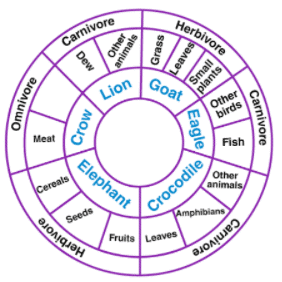
Q17: Connect the animal with the food it eats by an arrow using different colours in Fig. 1.4. One is done for you.
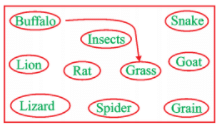
 View Answer
View Answer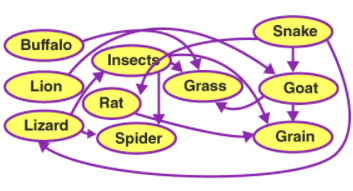 Buffalo – Grass
Buffalo – Grass
Lion – Goat
Lizard – Insects, Spider
Rat – Grain
Insect – Grain, Grass
Spider – Insects
Snake – Rat, Lizard, Goat
Goat – Grass, Grain
Q18: List two of your favorite food items and mention their ingredients.
 View Answer
View AnswerFood Items Ingredients
1. Dal curry Dal, onions, tomatoes, oil, water, salt, spices.
2. Kheer Rava, ghee, sugar, dry fruits.
|
99 videos|261 docs|49 tests
|
FAQs on NCERT Exemplar Solutions: Food - Where does it come from - Science Class 6
| 1. खाद्य पदार्थ कहाँ से आते हैं? |  |
| 2. खाद्य श्रृंखला का क्या महत्व है? |  |
| 3. खाद्य पदार्थों का उत्पादन कैसे किया जाता है? |  |
| 4. शाकाहारी और मांसाहारी आहार में क्या अंतर है? |  |
| 5. खाद्य पदार्थों की गुणवत्ता कैसे सुनिश्चित की जा सकती है? |  |

|
Explore Courses for Class 6 exam
|

|

















